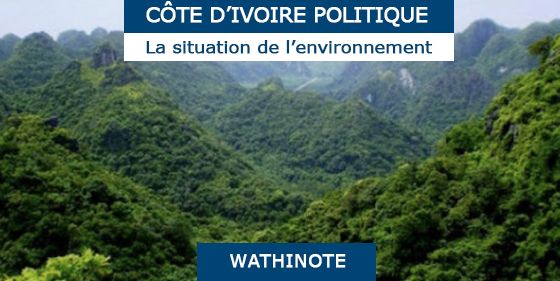Authors: Jean-Luc Kouassi , Amos Gyau , Lucien Diby, Yeboi Bene and Christophe Kouamé
Affiliated organization: Multidisciplinary Digital Publishing Institute (MDPI)
Type of publication: Article
Date of publication: Avril 2021
*Les Wathinotes sont des extraits de publications choisies par WATHI et conformes aux documents originaux. Les rapports utilisés pour l’élaboration des Wathinotes sont sélectionnés par WATHI compte tenu de leur pertinence par rapport au contexte du pays. Toutes les Wathinotes renvoient aux publications originales et intégrales qui ne sont pas hébergées par le site de WATHI, et sont destinées à promouvoir la lecture de ces documents, fruit du travail de recherche d’universitaires et d’experts.
Drivers of Deforestation and Land Degradation
The study indicated that the majority (89.78%) of the households found that deforestation was a reality in the study area. It resulted from an increase in the cultivated area and a reduction of the forest cover and the number of trees compared to the past. Deforestation took place at a rapid rate according to 32.36% of questioned people, while for 33.4% and 28.95% of the respondents, it occurred moderately and slowly, respectively. However, key informants from different institutions and FGDs perceived that the forest cover had considerably declined from 1987 to 2015.
The results showed that extensive agriculture (97.08%), shifting cultivation (48.91%), logging (47.69%) and fuelwood consumption (28.71%) remained the main direct drivers of deforestation. Harvesting practices, charcoal production, bushfires and infrastructure development such as roads and schools contributed to deforestation in a relatively small proportion.
This study revealed that the main indirect causes of deforestation were population growth (79.82%), migration (54.01%) and shifting cultivation practices (34.3%). Only a small proportion of interviewees indicated that the misuse of fertilizers and herbicides, education, weak legal frameworks, poor policies, increased market access, and land tenure uncertainties were part of the underlying drivers of deforestation.
Agriculture remained the main driver of rapid and moderate deforestation (94.4%) because it represented the most important means of subsistence for households. In addition to human activities causing deforestation, other factors mainly due to environmental issues include droughts and bushfires driven by lightning.
The results showed that extensive agriculture (97.08%), shifting cultivation (48.91%), logging (47.69%) and fuelwood consumption (28.71%) remained the main direct drivers of deforestation
In addition to deforestation, lands were also exposed to degradation as a result of cultural practices and other human activities. The study showed that nutrient depletion (72.02%) was the most important cause of land degradation. The shortening of the fallow period (46.72%) and the inappropriate application of inputs (31.39%) also contribute to land degradation. Only a small percentage of people interviewed stated that overgrazing, war and conflict, inappropriate irrigation and the occurrence and spread weeds and invader plants and bush encroachment could contribute to land degradation in the study area.
Effects and Benefits of Deforestation
According to respondents, the effects of deforestation could be either positive (51.34%) or negative (48.66%). On the one hand, the study showed that negative effects linked to deforestation on community and ecosystems encompassed land degradation (70.6%), loss of biodiversity (63.8%), global warming (56.9%) and loss of livelihood assets (54.3%).
Besides, deforestation increased household poverty mainly by causing a loss of production (69.6%), reducing land availability (61.6%), the loss of biodiversity (61.1%), increasing temperature (56%) and drought (37.7%). Furthermore, the study revealed that deforestation had socioeconomic effects by reducing food production (89.8%), reducing income (72%), and increasing health problems (46.2%). A small proportion (9%) of households experienced a loss in spiritual, aesthetic, cultural landscape and heritage values.
On the other hand, the results of the study revealed that deforestation had notable socio-economic benefits for households by contributing to livelihoods (85.6%) and by representing a source of income (88.6%) and employment (30.2%). By deforesting lands, farmers established food and cash crops while foresters set up sawmills that provided income and contributed to their livelihoods. Besides, sawmills are established in the landscape. These farms and sawmills are a source of employment for some young people looking for quick revenue.
Strategies to Reduce and Prevent Deforestation
Deforestation could be reduced by implementing adapted strategies to the region. In this study, the respondents argued that the main strategies to reduce deforestation were reforestation (41.2%), forest protection (26.8%), repression (18.2%) and sensitization. A small proportion proposed non-logging (8.1%), fallowing (3.9%), off-forest income-generating activities (3.9%) or other strategies (10%) such as participatory forest management, reducing agricultural lands, payment for ecosystem services, etc.


Commenter